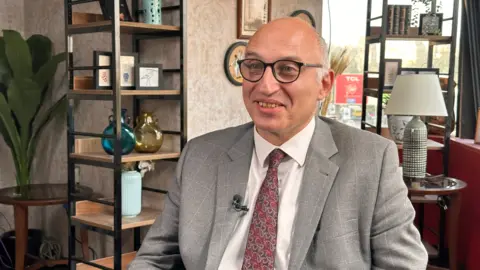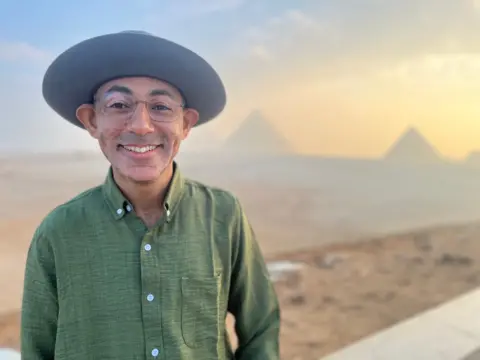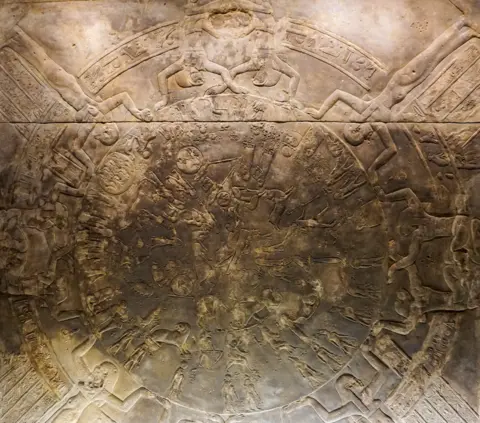ARTICLE AD BOX
Yolande Knell,Middle East correspondent, Jerusalem and Wael Hussein,Cairo

 Getty Images
Getty Images
The new museum will show all of the artefacts discovered by Howard Carter and his team in the tomb of Tutankhamun
Near one of the Seven Wonders of the Ancient World - the Great Pyramid of Khufu at Giza - Egypt is officially opening what it intends as a cultural highlight of the modern age.
The Grand Egyptian Museum (GEM), described as the world's largest archaeological museum, is packed with some 100,000 artefacts covering some seven millennia of the country's history from pre-dynastic times to the Greek and Roman eras.
Prominent Egyptologists argue that its establishment strengthens their demand for key Egyptian antiquities held in other countries to be returned – including the famed Rosetta Stone displayed at the British Museum.
A main draw of the GEM will be the entire contents of the intact tomb of the boy king Tutankhamun, displayed together for the first time since it was found by British Egyptologist Howard Carter. They include Tutankhamun's spectacular gold mask, throne and chariots.


Dr Tarek Tawfik says the museum's opening showcases the workmanship of ancient and modern Egyptians
"I had to think, how can we show him in a different way, because since the discovery of the tomb in 1922, about 1,800 pieces from a total of over 5,500 that were inside the tomb were on display," says Dr Tarek Tawfik, President of the International Association of Egyptologists and former head of the GEM.
"I had the idea of displaying the complete tomb, which means nothing remains in storage, nothing remains in other museums, and you get to have the complete experience, the way Howard Carter had it over a hundred years ago."
Costing some $1.2 bn (£910m; 1.1bn euros) the vast museum complex is expected to attract up to 8m visitors a year, giving a huge boost to Egyptian tourism which has been hit by regional crises.
"We hope the Grand Egyptian Museum will usher in a new golden age of Egyptology and cultural tourism," says Ahmed Seddik, a guide and aspiring Egyptologist by the pyramids on the Giza Plateau.
Apart from the Tutankhamun exhibit and a new display of the spectacular, 4,500-year-old funerary boat of Khufu - one of the oldest and best-preserved vessels from antiquity - most of the galleries at the site have been opened to the public since last year.
"I've been organising so many tours to the museum even though it was partially open," Ahmed goes on. "Now it will be at the pinnacle of its glory. When the Tutankhamun collection opens, then you can imagine the whole world will come back, because this is an iconic Pharoah, the most famous king of all antiquity."
"It's an absolute must-see," says Spanish tourist, Raúl, who is awaiting the full public opening on 4 November. "We're just waiting to go and check out all of the Egyptian artefacts," says Sam from London, who is on an Egypt tour. "It's a once in a lifetime opportunity."


Ahmed Seddik hopes that the museum's completion will bring even more tourists to Giza
Another British tourist says she previously saw the Tutankhamun exhibits on display at the neoclassical Egyptian Museum in bustling Tahrir Square. "The old museum was pretty chaotic, and it was a bit confusing," she comments. "Hopefully the Grand Museum will be a lot easier to take in and I think you will just get more out of it."
The new museum is colossal, spanning 500,000 square metres (5.4m sq ft) – about the size of 70 football pitches. The exterior is covered in hieroglyphs and translucent alabaster cut into triangles with a pyramid shaped entrance.
Among the GEM showstoppers are a 3,200-year-old, 16m-long suspended obelisk of the powerful pharaoh, Ramesses II, and his massive 11m-high statue. The imposing statue was moved from close to the Cairo railway station in 2006, in a complex operation, in preparation for the new institution.
A giant staircase is lined with the statues of other ancient kings and queens and on an upper floor a huge window offers a perfectly framed view of the Giza pyramids.
The museum was first proposed in 1992, during the rule of President Hosni Mubarak, and construction began in 2005. It has now taken nearly as long to complete as the Great Pyramid, according to estimates.

 Getty Images
Getty Images
The majority of the museum, including the Grand Staircase, has been open to the public since last year
The project was hit by financial crises, the 2011 Arab Spring – which deposed Mubarak and led to years of turmoil - the Covid 19 pandemic, and regional wars.
"It was my dream. I'm really happy to see this museum is finally opened!" Dr Zahi Hawass, Egypt's former long-time minister of tourism and antiquities, tells me. The veteran archaeologist says it shows that Egyptians are equals of foreign Egyptologists when it comes to excavations, preservation of monuments and curating museums.
"Now I want two things: number one, museums to stop buying stolen artefacts and number two, I need three objects to come back: the Rosetta Stone from the British Museum, the Zodiac from the Louvre and the Bust of Nefertiti from Berlin," says Dr Hawass.
He has set up online petitions – attracting hundreds of thousands of signatures – calling for all three items to be repatriated.
The Rosetta Stone, found in 1799, provided the key to deciphering hieroglyphics; it was discovered by the French army and was seized by the British as war booty. A French team cut the Dendera Zodiac, an ancient Egyptian celestial map, from the Temple of Hathor in Upper Egypt in 1821. Egypt accuses German archaeologists of smuggling the colourfully painted bust of Nefertiti, wife of Egyptian pharaoh Akhenaten, out of the country more than a century ago.
"We need the three objects to come as a good feeling from these three countries, as a gift, as Egypt gave the world many gifts," Dr Hawass says.

 Getty Images
Getty Images
The Dendera Zodiac is currently in the Louvre but the opening of the Grand Egyptian Museum has renewed calls for it to be returned
Another leading Egyptologist, Dr Monica Hanna, names the same objects, "taken under a colonialist pretext," as ones which must be repatriated. She adds: "The GEM gives this message that Egypt has done its homework very well to officially ask for the objects."
The British Museum told the BBC that it had received: "No formal requests for either the return or the loan of the Rosetta Stone from the Egyptian Government."
Egyptian Egyptologists voice their excitement about the new museum becoming a centre for academic research, driving new discoveries.
Already, Egyptian conservators based there have painstakingly restored items belonging to Tutankhamun, including his impressive armour made of textiles and leather. According to Egyptian law, such restorations can only be done by Egyptians.
"Colleagues from around the world have been in awe of the fantastic conservation work that has been done," says Dr Tarek Tawfik, adding that the entire project is a source of great national pride. "As well as ancient Egyptian history, we are also showcasing modern Egypt because it's Egypt that built this museum."

 17 hours ago
10
17 hours ago
10








 English (US) ·
English (US) ·